The Samsung Galaxy S7 & S7 Edge Review, Part 1
by Joshua Ho on March 8, 2016 9:00 AM ESTGPU Performance
On the GPU side of things, Qualcomm's Snapdragon 820 is equipped with the Adreno 530 clocked at 624 MHz. In order to see how it performs, we ran it through our standard 2015 suite. In the future, we should be able to discuss how the Galaxy S7 performs in the context of our new benchmark suite as we test more devices on our new suite to determine relative performance.
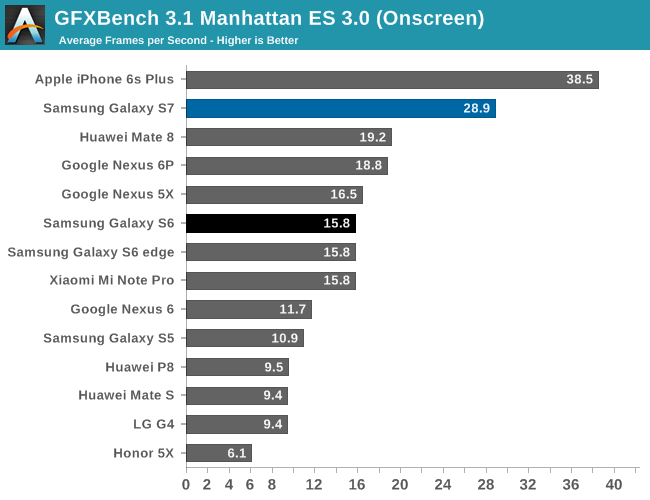

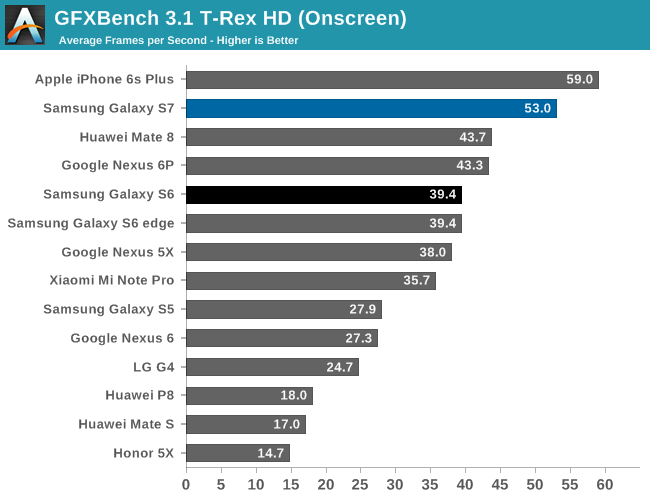
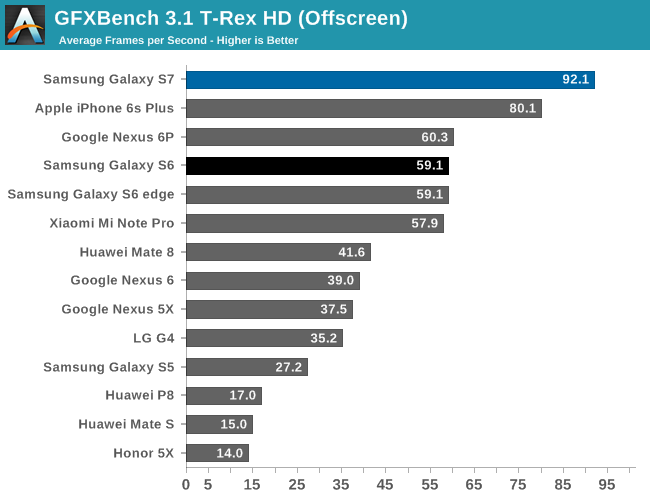
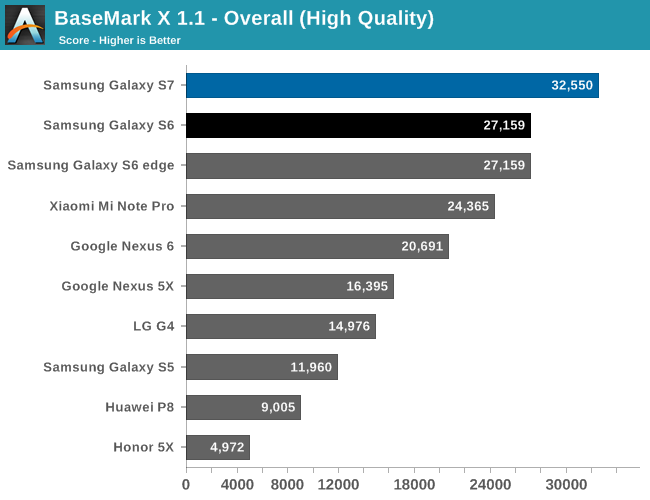

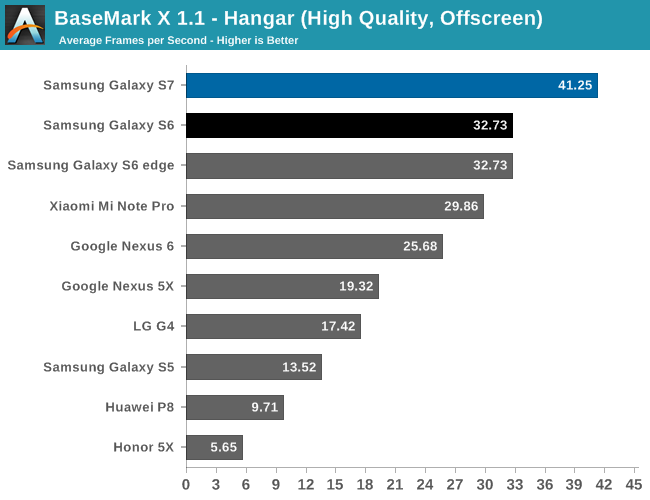
At a high level, GPU performance appears to be mostly unchanged when comparing the Galaxy S7 to the Snapdragon 820 MDP. Performance in general is quite favorable assuming that the render resolution doesn't exceed 2560x1440.
Overall, the Adreno 530 is clearly one of the best GPUs you can get in a mobile device today. The Kirin 950's GPU really falls short in comparison. One could argue that turbo frequencies in a GPU don't make a lot of sense, but given that mobile gaming workloads can be quite bursty in nature and that gaming sessions tend to be quite short I would argue that having a GPU that can achieve significant levels of overdrive performance makes a lot of sense. The A9 is comparable if you consider the resolution of iOS devices, but when looking at the off-screen results the Adreno 530 pulls away. Of course, the real question now is how the Adreno 530 compares to the Exynos 8890's GPU in the international Galaxy S7, but that's a question that will have to be left for another day.










202 Comments
View All Comments
jjj - Wednesday, March 9, 2016 - link
One last time , these apps due to the different core configs can change the rankings. The one that gets 20h could go to 12 and the one with 16 to 14h.That was the main point here.Because the vast majority of users have such apps, you can't reach relevant results without factoring them in.A phone can get good results in the current test and poor in actual usage.retrospooty - Wednesday, March 9, 2016 - link
That is an extremely unlikely example. In real world usage, Octa cores have had very little difference in any area (performance or efficiency) vs. their quad core counterparts unless there is an issue with the ROM where it's simple bleeding power. Whatever though, if you feel so strongly about it, by all means, do some testing on various phones and submit to a few sites and see how worthwhile it is.jospoortvliet - Friday, March 11, 2016 - link
I'm no fan of the hitching at the AND team but he has a point with the background tasks - an average modern phone has a lot of them and testing endurance with them all disabled isn't realistic. Moreover, indeed a dual core would probably perform worse with more background tasks than a quad-core or octacore as they can spread the load and keep their cores at an energy-efficient optimal speed.A repeatable, fixed background load would be good to have. Also hard to write, certainly across ios and Android due to their different capabilities and limitations with regards to background tasks. So I get why it hasn't been done and if jjj is up for writing a tool that does it I bet the anandtech team would take it... Yeah.
leexgx - Monday, March 14, 2016 - link
the only thing i find with anandtech is battery tests is that they do not follow real world battery use (to get correct results divide it by about 2 or 2.5 and there is your real battery use, when you look at anandtech reviews, all other tests are good, most phones last around 4 hours Screen on time (max tends to be 4 hours but can be as low as 1.5 hours)the only exception to that rule tends to be the
Motorola RAZR MAXX phones (Low end CPU with 3200 battery),
CUBOT H1 1Ghz Quad core, 720p screen {basicly Samsung Note 2 spec} with Massive 5200 battery, (i own and love, and only costs £110 !!) still miss not having the HTC ONE stereo speakers but i take 8 hours over 2 hours (without having to use an external battery case that turns it into a brick)
and the Huawei Mate 8 (4000 battery)
Andrei Frumusanu - Tuesday, March 8, 2016 - link
GFXBench long term performance is currently not useful to anybody as it hits Vsync in the current T-Rex test. In the full review we'll have a proper test which will be of use for users.jjj - Tuesday, March 8, 2016 - link
Seems that you might be wrong Andrei. I am guessing you got the MI5 but that's 1080p and you forgot to factor that in? Here at 1440p you don't hit the 60FPS wall even in the first run.If the MI5 doesn't fall bellow 60FPS with the 1080p, it would be relatively good news, as it means less than 33%-ish throttling with a 1080p display and no heatpipe.
hansmuff - Tuesday, March 8, 2016 - link
This German review posted some GFXbench results you might be interested in, however ofc their phone uses Exynos. Hard to say that Snapdragon would behave the same way, but it's also clear that having a heatpipe alone in the phone doesn't mean it won't throttle.. significantly at some points.http://www.computerbase.de/2016-03/samsung-galaxy-...
jjj - Tuesday, March 8, 2016 - link
Thanks a lot, ofc has nothing to do with SD820 but having this for the Exynos is nice too.Digitimes was claiming that only the SD820 models have the heatpipe, no clue if true or not, guess it's something else that has to be verified.
jjj - Tuesday, March 8, 2016 - link
The Exynos models do have the heatpipe too.tuxRoller - Tuesday, March 8, 2016 - link
Is that what you do with your phone? Run continuous benchmarks all day?I understand we want an idea about throttling but using those benchmarks as proxy for expected performance won't get you that info about day to day usage.